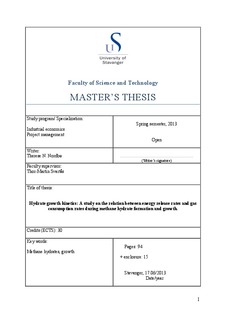| dc.contributor.author | Nordbø, Therese | |
| dc.date.accessioned | 2013-10-28T14:53:44Z | |
| dc.date.available | 2013-10-28T14:53:44Z | |
| dc.date.issued | 2013 | |
| dc.identifier.uri | http://hdl.handle.net/11250/182230 | |
| dc.description | Master's thesis in Industrial economics | no_NO |
| dc.description.abstract | The relation between mass transfer, energy transfer and growth rates has been examined during methane hydrate formation in stirred cell reactors. This was done to improve understanding rate determining factors during hydrate formation and growth.
In stirred cell reactor heat transfer and heat transfer rates will be functions of stirring rate and through boundary layers at the wall. The heat transfer rate is also function of temperature gradients. Experiments have thus been conducted at three different stirring rates and temperatures levels to evaluate the effect of stirring and temperature gradients on heat transfer.
Experiments have been conducted using two different cell setups, a smaller cell having a volume of 141.4 ml and with inner diameter of 60 mm, outer diameter of 90 mm and a height of 50 mm, and a larger cell having a volume of 318.1 ml and with an inner diameter of 90 mm, outer diameter of 120 mm and a height of 50 mm. The cell systems were connected to a high pressure methane reservoir via a pressure reduction valve and a flow meter and operated in an open mode to maintain constant pressure throughout the experiments.
In the smaller cell hydrate formation and growth was studied at three different experimental temperatures of 6, 7 and 8 °C and at stirring rates of 500, 700 and 1200 rpm using either 50 ml or 100 ml distilled water (DW). In the larger cell experiments were conducted at 8 °C and 700 rpm to examine effects of cell size and radial heat flow. The volume of water was either 112.5 ml or 225 ml for the large cell experiments.
Hydrate growth rates were estimated analyzing the amount of gas passing through the flow-meter per time unit and the amount of heat released (exothermic reaction) through temperature measurements. The analysis was terminated when heat release was observed to decay and prior to complete conversion of water into hydrates to reduce effects of increasing hydrate mass on heat transfer. The growth rate was initially relatively fast and decaying towards the end of the period analyzed. The analyzed growth period could be devided into three different rate section (Initial rate 1, Mid-section rate 2 and End-section rate 3) and within each section the rate could be approximated a linear function of time.
Gas consumption by hydrate formation was used to calculate the heat production and heat flow into the cell. Heat flow out of the cell reactor was calculated on basis of measured temperature differences and the required heat input to balance the heat loss was estimated by simulations. Ideally this estimated heat input should be equal with the energy released by hydrate formation as calculated from the measured gas consumption during the process. The analysis was terminated when heat release was observed to decay as function of time and prior to complete conversion of water into hydrates to reduce effects of increasing hydrate mass on heat transfer.
Discrepancies between energy / heat flow into the cell calculated from formation enthalpy and a value estimated on the basis of temperature measurements was used to evaluate the effect of stirring rate on heat transfer and the used heat transfer coefficients during simulations.
Generally the simulated heat flow into the cell was higher than that calculated from the formation enthalpy indicating that heat transfer coefficients were overestimated. | no_NO |
| dc.language.iso | eng | no_NO |
| dc.publisher | University of Stavanger, Norway | no_NO |
| dc.relation.ispartofseries | Masteroppgave/UIS-TN-IØRP/2013; | |
| dc.subject | industriell økonomi | no_NO |
| dc.subject | methane hydrates | no_NO |
| dc.subject | growth | no_NO |
| dc.title | Hydrate growth kinetics: A study on the relation between energy release rates and gas consumption rates during methane hydrate formation and growth. | no_NO |
| dc.type | Master thesis | no_NO |
| dc.subject.nsi | VDP::Technology: 500 | no_NO |
| dc.subject.nsi | VDP::Social science: 200::Economics: 210 | no_NO |
